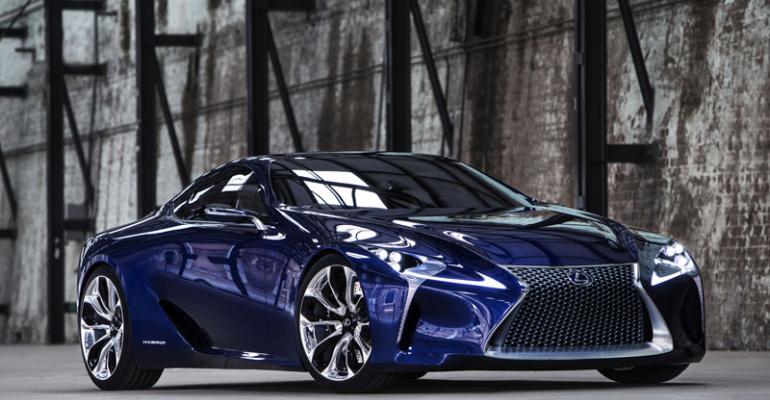AUSTIN, TX – Lexus confirms the LF-LC concept car will enter production, a move long rumored since the rear-wheel-drive hybrid sport coupe was introduced to much fanfare at the 2012 North American International Auto Show in Detroit.
“That was (intended as) a concept car, and I think it surprised everybody, including us, when Japan said due to overwhelming response they decided to do it,” Brian Smith, Lexus’ vice president-marketing, tells WardsAuto at a recent media event here. “It’s a huge win.”
Smith declines to reveal details about the LF-LC, including when production will begin.
The concept was a studio-wide effort by Toyota's Newport Beach, CA-based designers to "advance the redefinition of Lexus with emotive, avant-garde beauty and advanced technology, yet remain within reach for premium buyers."
It’s unclear where the LF-LC will slot into Lexus’ lineup, although it likely will be built in limited numbers and priced above most of the brand’s mainstream products. It also is unknown if the production coupe will have a hybrid powertrain like the concept, as speculation has pegged the car as the successor to the non-hybrid, discontinued SC 430.
The GT Channel, a car enthusiast website, says the production car may be named the LC 550 and incorporate many of the concept’s design elements.
Even with the addition of the LF-LC, Smith says holes remain in Lexus’ lineup. Among models needed are more cross/utility vehicles, which are growing in popularity worldwide.
The Lexus RX currently is the only CUV in the luxury marque’s lineup. A number of auto makers, including Ford’s Lincoln division, have cited small CUVs as an area of growth in the luxury segment.
“In general, CUVs of any size are becoming a bigger force in the industry. So as we sell more products globally, I think that could lead to new products for us,” Smith says, declining to reveal details.
Smith says one of the brand’s two large body-on-frame SUVs, the GX and LX, could be converted to unibody platforms as the auto maker works to meet looming government-imposed fuel-economy regulations.
“In the future, if we could do a 3-row unibody (utility vehicle), I think that’s what consumers would want to see,” he says.
Smith says Lexus has no plans to introduce a diesel powertrain in the U.S., noting the auto maker is known for hybrids, which he considers a better fuel-economy solution.
Lexus’ European competitors are “sort of forced to go diesel because that’s where their skill set is,” he says. “And I think it still remains to be seen the acceptance of diesel in the U.S. It’s clearly improving, but hybrid is an easy sell.”
As for borrowing plug-in hybrid-electric vehicle technology from parent Toyota, Smith says it likely wouldn’t appeal to luxury consumers who want a no-compromise vehicle.
“For PHEVs, the target is somebody who drives shorter distances and wants to maximize the electric range, and I don’t think that’s where luxury is,” he says.
There currently are no plans for an entry-level non-hybrid car to slot in under the all-new ’14 IS sport coupe, although Smith says that remains a possibility if the market demands it. Lexus retails the compact hybrid hatchback CT 200h in the U.S.
Luxury competitors have been forced to offer entry-level vehicles to meet fuel-economy mandates, but Smith says Lexus, due to its grouping with Toyota and Scion, does not need such fuel-sippers.
However, he says Lexus will continue to monitor the trend toward small, entry-level luxury vehicles. And if there’s sufficient demand, “Lexus might go there someday.”





